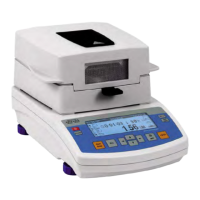Liquid substances
It refers to liquid substances, which by creation of drops on their surface,
caused by surface tension, may render difficulties in drying process. In such cases,
it is proved to use a glass fiber filter to shorten measurement time. The filter causes
separating tested liquid around the fibers, and increasing active evaporating
surface. Initial filter drying is necessary only in case of measurements which require
very high accuracy.
Substances with structure of leather or temperature sensitive
In case of such substances it is proved to a glass fibre filter. While testing, a
substance is placed on a drying pan, and sample surface is covered with a filter,
which protects the sample from direct heat radiation. In such case, the sample is
heated by convection (which is milder than radiation).
Substances containing sugar
The surface of such substances often may caramelize during testing
procedure. Therefore, it is recommended to use thin layer of a sample, and
moderate drying temperature.
Sample distribution on drying pan:
Loose materials
Dried in their natural state, i.e. in their natural form or disintegrated. Sample
disintegration causes smaller dispersion
between the following measurements. Sample
mass should not be too high, and the sample
should be evenly spread on whole surface of
the drying pan.
Liquid substances
Semi-fluid substances are dried in their natural form. Large amount of grease (fat)
occurring in some of substances make moisture content determination difficult. In
such case it is recommended to use additional
components, which increase sample’s active surface
and aid moisture content releasing process from a
sample. such components are high silica sand,
blotting paper or filter. Before drying a tested
substance, initially dry the additional component, so
that its humidity is close to zero.
Solid objects
Depending on solid object’s structure (dense or loose), moisture content
determining process may take short or long time.
The size of solid’s surface determines the speed of
drying process, and measurement reliability. Thus,
the surface of a solid object should be as large as
possible. Since solid objects release moisture
through their outer surface, sample thickness is
another important factor.

